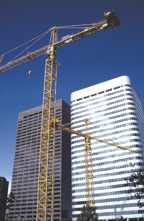
Have you ever wondered how a high-rise is constructed? Before a building can soar into the sky, engineers spend countless hours developing an underground support system and testing the materials that comprise the building. Before the columns, walls, and windows take shape on a high-rise building, significant work takes place to develop a solid foundation below ground. The key component to a high-rise’s stability involves testing, research, and installation of a foundation system ensuring the building doesn’t sink, tilt, or crack.
To develop a foundation that will support the weight of the building, the geotechnical engineer starts by using soil borings to collect soil samples, which are sent to a laboratory for analysis. In addition, in situ pressuremeter testing is used to help determine the bearing capacity and settlement potential of the soil or rock. After determining the strength of the soil, the geotechnical engineer provides recommendations to the structural engineer on how to support the load of the building.
The next step is to determine the proper type of foundation. There are numerous foundation solutions for supporting the building, including caissons, piles, barrettes, mats, spread footings, or combinations of these systems. The type of foundation and materials depend on the ground conditions and structure above it. To prove the foundation design can support the structure, the geotechnical engineer may develop a “load test program.” A production or sacrificial foundation is constructed and loaded either with heavy weights or by jacking. This simulates the load of the proposed building, while measuring the amount of settlement. The program confirms the foundation load is safe and adequate, thus saving the client money on other more expensive foundation systems.
Finally, as the foundation system is being installed, technicians are on site to ensure the geotechnical engineer’s recommendations are followed. They check the soil conditions at the base of the foundation excavation, obtain samples of the foundation concrete and proposed fill, and perform density testing during backfilling. As the floors and exterior are installed, the quality of the materials and construction is monitored. The high value and critical applications of these building materials make sensitive and reliable acceptance testing essential. The goal is to choose materials and develop procedures that will produce enhanced durability and extended service life. During this stage, the concrete-and-steel framing is tested to verify its performance to specifications, and adjustments are made if necessary. The cladding system is tested for material properties, the installation of the exterior (curtain wall) is inspected, watertight conditions are tested, and the roof membranes are inspected.
Engineers, architects, and developers spend many years planning, testing, and constructing these complex structures. From this short article, you can begin to understand some of the steps involved in the construction of a high-rise building. The next time you gaze into the sky at a tall building, remember: what you don’t see below the ground is key to what you do see above it. IBI
To develop a foundation that will support the weight of the building, the geotechnical engineer starts by using soil borings to collect soil samples, which are sent to a laboratory for analysis. In addition, in situ pressuremeter testing is used to help determine the bearing capacity and settlement potential of the soil or rock. After determining the strength of the soil, the geotechnical engineer provides recommendations to the structural engineer on how to support the load of the building.
The next step is to determine the proper type of foundation. There are numerous foundation solutions for supporting the building, including caissons, piles, barrettes, mats, spread footings, or combinations of these systems. The type of foundation and materials depend on the ground conditions and structure above it. To prove the foundation design can support the structure, the geotechnical engineer may develop a “load test program.” A production or sacrificial foundation is constructed and loaded either with heavy weights or by jacking. This simulates the load of the proposed building, while measuring the amount of settlement. The program confirms the foundation load is safe and adequate, thus saving the client money on other more expensive foundation systems.
Finally, as the foundation system is being installed, technicians are on site to ensure the geotechnical engineer’s recommendations are followed. They check the soil conditions at the base of the foundation excavation, obtain samples of the foundation concrete and proposed fill, and perform density testing during backfilling. As the floors and exterior are installed, the quality of the materials and construction is monitored. The high value and critical applications of these building materials make sensitive and reliable acceptance testing essential. The goal is to choose materials and develop procedures that will produce enhanced durability and extended service life. During this stage, the concrete-and-steel framing is tested to verify its performance to specifications, and adjustments are made if necessary. The cladding system is tested for material properties, the installation of the exterior (curtain wall) is inspected, watertight conditions are tested, and the roof membranes are inspected.
Engineers, architects, and developers spend many years planning, testing, and constructing these complex structures. From this short article, you can begin to understand some of the steps involved in the construction of a high-rise building. The next time you gaze into the sky at a tall building, remember: what you don’t see below the ground is key to what you do see above it. IBI

